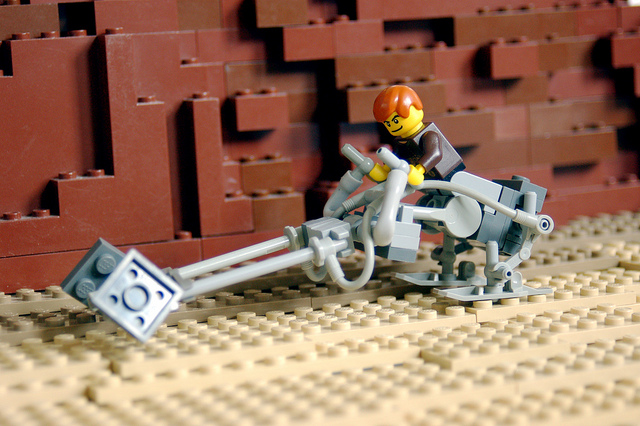Posts Tagged ‘Fear’
The Leader’s Journey
 If you know what to do, do it. Don’t ask, just do.
If you know what to do, do it. Don’t ask, just do.
If you’re pretty sure what to do, do it. Don’t ask, just do.
If you think you may know what to do, do it. Don’t ask, just do.
If you don’t know what to do, try something small. Then, do more of what works and less of what doesn’t.
If your team doesn’t know what to do unless they ask you, tell them to do what they think is right. And tell them to stop asking you what to do.
If your team won’t act without your consent, tell them to do what they think is right. Then, next time they seek your consent, be unavailable.
If the team knows what to do and they go around you because they know you don’t, praise them for going around you. Then, set up a session where they educate you on what you should know.
If the team knows what to do and they know you don’t, but they don’t go around you because they are too afraid, apologize to them for creating a fear-based culture and ask them to do what they think is right. Then, look inside to figure out how to let go of your insecurities and control issues.
If your team needs your support, support them.
If your team need you to get out of the way, go home early.
If your team needs you to break trail, break it.
If they need to see how it should go, show them.
If they need the rules broken, break them.
If they need the rules followed, follow them.
If they need to use their judgement, create the causes and conditions for them to use their judgement.
If they try something new and it doesn’t go as anticipated, praise them for trying something new.
If they try the same thing a second time and they get the same results and those results are still unanticipated, set up a meeting to figure out why they thought the same experiment would lead to different results.
Try to create the team that excels when you go on vacation.
Better yet, try to create the team that performs extremely well when you’re involved in the work and performs even better when you’re on vacation. Then, because you know you’ve prepared them for the future, happily move on to your next personal development opportunity.
Image credit — Puriri deVry
It’s time to stretch yourself.
 If the work doesn’t stretch you, choose new work. Don’t go overboard and make all your work stretch you and don’t choose work that will break you. There’s a balance point somewhere between 0% and 100% stretch and that balance point is different for everyone and it changes over time. Point is, seek your balance point.
If the work doesn’t stretch you, choose new work. Don’t go overboard and make all your work stretch you and don’t choose work that will break you. There’s a balance point somewhere between 0% and 100% stretch and that balance point is different for everyone and it changes over time. Point is, seek your balance point.
To find the right balance point, start with an assessment of your stretch level. List the number of projects you have and sum the number of major deliverables you’ve got to deliver. If you have more than three projects, you have too many. And if you think you take on more than three because you’re superhuman, you’re wrong. The data is clear – multitasking is a fallacy. If you have four projects you have too many. And it’s the same with three, but you’d think I was crazy if I suggested you limit your projects to two. The right balance point starts with reducing the number of projects you work on.
Now that you eliminated four or five projects and narrowed the portfolio down to the vital two or three, it’s time to list your major deliverables. Take a piece of paper and write them in a column down the left side of the page. And in a column next to the projects, categorize each of them as: -1 (done it before), 0 (done something similar), 1 (new to me), 2 (new to team), 3 (new to company), 5 (new to industry), 11 (new to world).
For the -1s, teach an entry level person how to do it and make sure they do it well. For the 0s, find someone who deserves a growth opportunity and let them have the work. And check in with them to make sure they do a good job. The idea is to free yourself for the stretch work.
For the 1s, find the best person in the team who has done it before and ask them how to do it. Then, do as they suggest but build on their work and take it to the next level.
For the 2s, find the best person in the company who has done it before and ask them how to do it. Then, build on their approach and make it your own.
For the 3s, do your research and find out who in your industry has done it before. Figure out how they did it and improve on their work.
For the 5s, do your research and figure out who has done similar work in another industry. Adapt their work to your application and twist it into something magical.
And for the 11s, they’re a special project category that live in rarified air and deserve a separate blog post of their own.
Start with where you are – evaluate your existing deliverables, cull them to a reasonable workload and assess your level of stretch. And, where it makes sense, stop doing work you’ve done before and start doing work you haven’t done yet. Stretch yourself, but be reasonable. It’s better to take one bite and swallow than take three and choke.
Image credit – filtran
The Evolution of New Ideas
 Before there is something new to see, there is just a good idea worthy of a prototype. And before there can be good ideas there are a whole flock of bad ones. And until you have enough self confidence to have bad ideas, there is only the status quo. Creating something from nothing is difficult.
Before there is something new to see, there is just a good idea worthy of a prototype. And before there can be good ideas there are a whole flock of bad ones. And until you have enough self confidence to have bad ideas, there is only the status quo. Creating something from nothing is difficult.
New things are new because they are different than the status quo. And if the status quo is one thing, it’s ruthless in desire to squelch the competition. In that way, new ideas will get trampled simply based on their newness. But also in that way, if your idea gets trampled it’s because the status quo noticed it and was threatened by it. Don’t look at the trampling as a bad sign, look at it as a sign you are on the right track. With new ideas there’s no such thing as bad publicity.
The eureka moment is a lie. New ideas reveal themselves slowly, even to the person with the idea. They start as an old problem or, better yet, as a successful yet tired solution. The new idea takes its first form when frustration overcomes intellectual inertia a strange sketch emerges on the whiteboard. It’s not yet a good idea, rather it’s something that doesn’t make sense or doesn’t quite fit.
The idea can mull around as a precursor for quite a while. Sometimes the idea makes an evolutionary jump in a direction that’s not quite right only to slither back to it’s unfertilized state. But as the environment changes around it, the idea jumps on the back of the new context with the hope of evolving itself into something intriguing. Sometimes it jumps the divide and sometimes it slithers back to a lower energy state. All this happens without conscious knowledge of the inventor.
It’s only after several mutations does the idea find enough strength to make its way into a prototype. And now as a prototype, repeats the whole process of seeking out evolutionary paths with the hope of evolving into a product or service that provides customer value. And again, it climbs and scratches up the evolutionary ladder to its most viable embodiment.
Creating something new from scratch is difficult. But, you are not alone. New ideas have a life force of their own and they want to come into being. Believe in yourself and believe in your ideas. Not every idea will be successful, but the only way to guarantee failure is to block yourself from nurturing ideas that threaten the status quo.
Image credit – lost places
Starting 101
 Doing challenging work isn’t difficult. Starting challenging work is difficult.
Doing challenging work isn’t difficult. Starting challenging work is difficult.
The downside of making a mistake is far less than the downside of not starting.
If you know how it will turn out, you waited too long to start.
Stopping is fine, as long as it’s followed closely by starting.
The scope of the project you start is defined by the cash in your pocket.
If you don’t start you can’t learn.
The project doesn’t have to be all figured out before starting, you just have to start.
Starting is scary because it’s important.
Before you can start you’ve got to decide to start.
If you’re finally ready to start, you should have started yesterday.
Without starting there can be no finishing.
Starting is blocked by both the fear of success and the fear of failure.
You don’t need to be ready to start, you just need to start.
The only thing in the way of starting is you.
Image credit — Dermot O’Halloran
Make It Easy
 When you push, you make it easy for people resist. When you break trail, you make it easy for them to follow.
When you push, you make it easy for people resist. When you break trail, you make it easy for them to follow.
Efficiency is overrated, especially when it interferes with effectiveness. Make it easy for effectiveness to carry the day.
You can push people off a cliff or build them a bridge to the other side. Hint – the bridge makes it easy.
Even new work is easy when people have their own reasons for doing it.
Making things easier is not easy.
Don’t tell people what to do. Make it easy for them to use their good judgement.
Set the wrong causes and conditions and creativity screeches to a halt. Set the right ones and it flows easily. Creativity is a result.
Don’t demand that people pull harder, make it easier for them to pull in the same direction.
Activity is easy to demonstrate and progress isn’t. Figure out how to make progress easier to demonstrate.
The only way to make things easier is to try to make them easier.
Image credit – Richard Hurd
Complaining isn’t a strategy.
 It’s easy to complain about how things are going, especially when they’re not going well. But even with the best intentions, complaining doesn’t move the organization in a new direction. Sometimes people complain to attract attention to an important issue. Sometimes it’s out of frustration, sometimes out of sadness and sometimes out of fear, but it’s never the best mechanism.
It’s easy to complain about how things are going, especially when they’re not going well. But even with the best intentions, complaining doesn’t move the organization in a new direction. Sometimes people complain to attract attention to an important issue. Sometimes it’s out of frustration, sometimes out of sadness and sometimes out of fear, but it’s never the best mechanism.
If the intention is to convey importance, why not convey the importance by explaining why it’s important? Why not strip the issue of its charge and use an approach and language that help people understand why it’s important? It’s a simple shift from complaining to explaining, but it can make all the difference. Where complaining distracts, explaining brings people together. And if it’s truly important, why not take the time to have a give-and-take conversation and listen to what others have to say? Instead of listening to respond, why not listen to understand?
If you’re not willing to understand someone else’s position it’s not a conversation.
And if you’re on the receiving end of a complaint, how can you learn to see it as a sign of importance and not as an attack? As the receiver, why not strip it of its charge and ask questions of clarification? Why not deescalate and move things from complaint to conversation? Understanding is not agreeing, but it still a step forward for everyone.
When two sides are divided, complaining doesn’t help, even if it’s well-intentioned. When two sides are divided and there’s strong emotion, the first step is to take responsibility to deescalate. And once emotions are calmed, the next step is to take responsibility to understand the other side. At this stage, there is no requirement to agree, but there can be no hint of disagreement as it will elevate emotions and set progress back to zero. It’s a slow process, but when the issues are highly charged, it’s the fastest way to come together.
If you’re dissatisfied with the negativity, demonstrate positivity. If you want to come together, take the first step toward the middle. If you want to generate the trust needed to move things forward, take action that builds trust.
If you want things to be different, look inside.
Image credit – Ireen2005
The Duplicitous Relationship Between Time and Money
 If you had a choice to make an extra year’s salary or live an extra year, which would you choose? If you had a choice to make an extra month’s salary or live an extra month, make the same choice? What about the trade between a week’s pay and a week of life? Does anything change when it’s a choice between ten years of salary and ten years of life? Does this thought experiment change anything for you? If not, no worries. It was a low-cost experiment.
If you had a choice to make an extra year’s salary or live an extra year, which would you choose? If you had a choice to make an extra month’s salary or live an extra month, make the same choice? What about the trade between a week’s pay and a week of life? Does anything change when it’s a choice between ten years of salary and ten years of life? Does this thought experiment change anything for you? If not, no worries. It was a low-cost experiment.
If you decided you had enough money, how would you change your behavior? Would you spend more time with your kids? Would you take the time to decompress and enjoy what you have? Or would you spend more money so no longer had enough? What if next week you pretend you have enough money? Would things change? Is there a downside to spending more time with your family next week? Why not try it?
If every day you reminded yourself your lifespan was finite, would you live differently? If you reminded yourself every morning for the next week, would things change? It’s a low-cost experiment, and only the first two mornings are scary. The experiment is free. Why not try?
What if you decided you didn’t want a promotion? Would you work differently? Would you use more judgment because the cost of failure is lower? Would you take more initiative? Would you say no more often? Or would you say yes more often? Would you choose to work on different projects? Why not try it for a week? Who knows, you may get a promotion.
What if you decided you had enough stuff? What would you do with the extra money? Would give some to charity? Would you save up and buy more stuff? For the next week, why not remove one thing from your house and recycle it or give it away? You may teach yourself you have too much stuff; you may teach yourself your house looks better when it’s less cluttered, or you may feel good that your gift helped someone who didn’t have enough. There’s little downside to more pocket change, a decluttered house and helping others. Why not try it next week?
Every day we make trades between time and money, but we make them in a below-the-water-level way. And every day we choose between having enough or not, and, again, we make these choices in a less-than-fully-conscious way. But these choices are far too important to make lightly.
Why not make some time every day to quiet yourself so you can be more aware of the day’s decisions? It’s a low-cost experiment that could bring more clarity to your decision-making. Why not try it for a week?
image credit – Tax Credits
Put Yourself Out There
 If you put yourself out there and it doesn’t go as you expect, don’t get down. All you are responsible for is your effort and your intentions. You’re not responsible for the outcome. Intentions don’t drive outcomes. In fact, be prepared for your work to bring out the opposite of your intentions.
If you put yourself out there and it doesn’t go as you expect, don’t get down. All you are responsible for is your effort and your intentions. You’re not responsible for the outcome. Intentions don’t drive outcomes. In fact, be prepared for your work to bring out the opposite of your intentions.
If you put yourself out there and it goes poorly, don’t judge yourself negatively. Sometimes, things go that way. It’s not a problem, unless you make it one. So, don’t make it one. Just put yourself out there.
The clothes don’t get clean without an agitator. Hold onto that, and put yourself out there.
How do you know you’ve put yourself out there? The status quo is angry with you. The people in power want you to stop. The organization tries to scuttle your work. And the people that know the truth take you out to lunch.
If you put yourself out there and your message is met with 100% agreement, you didn’t put yourself out there. You may have stepped outside the lines, but you didn’t put your whole self on the line. You didn’t splash everyone with a full belly flop. There wasn’t enough sting and your belly isn’t red enough.
You won’t get it right, but put yourself out there anyway. You can’t predict the outcome, but take a run at the status quo. You don’t know how it will turn out, but that’s not a reason to hold back, it’s objective evidence it’s time to take a run at it.
Don’t put yourself out there because it’s the right thing to do, put yourself out there because you have an emotional connection. Put yourself out there because it’s time to put yourself out there. Put yourself out there because you don’t know what else to do.
Be prepared to be misunderstood, but put yourself out there. Expect to be laughed at and talked about behind your back, but put yourself out there. And expect there will be one or two people who will have your back. You know who they are.
No sense holding back. Get over the fear and put yourself out there.
The only one holding you back is you.
Image credit – Mark Bonica
Success – the Enemy of New Work
 Success is the enemy of new work. Past success blocks new work out of fear it will jeopardize future success, and future success blocks new work out of fear future success will actually come to be.
Success is the enemy of new work. Past success blocks new work out of fear it will jeopardize future success, and future success blocks new work out of fear future success will actually come to be.
Either way you look at it, success gets in the way of doing new work.
Success itself has no power to block new work. To generate its power, past success creates the fear of loss in the people doing today’s work. And their fear causes them to block new work. When we did A we got success, and now you are trying to do B. B is not A, and may not bring success. I will resist B out of fear of losing the goodness of past success.
As a blocking agent, future success is more ethereal and more powerful because it prevents new work from starting. Future success causes our minds to project the goodness and glory the new work could bring and because our small sense of self doesn’t think we’re worthy, we never start. Where past success creates an enemy in the status quo, future success creates an enemy within ourselves.
But if we replace fear with learning, the game changes.
I’m not trying to displace our past success, I’m trying to learn if we can use it as springboard and back flip into the deep end of our future success. If it works, our learning will refine today’s success and inform tomorrow’s. If it doesn’t work, we’ll learn what doesn’t work and try something else. But not to worry, we’ll make small bets and create big learning. That way when we jump in the puddle, the splash will be small. And if the water’s cold, we’ll stop. But if it’s warm, we’ll jump into a bigger puddle. And maybe we’ll jump together. What do you think? Will you help me learn?
Yes, it’s scary to think about running this small experiment. Not because it won’t work, but because it might. If we learn this could work it would be a game-changer for the company and I’m afraid I’m not worthy of the work. Can you help me navigate this emotional roller coaster? Can you help me learn if this will work? Can you review the results privately and help me learn what’s going on? If we don’t learn how to do it, our competitors will. Can you help me start?
Success blocks, but it also pays the bills. And, hopefully it’s always part of the equation. But there are things we can do to take the edge of its blocking power. Acknowledge that new work is scary and focus on learning. Learning isn’t threatening, and it moves things forward. Show results and ask for comments from people who created past success. Over time, they’ll become important advocates. And acknowledge to yourself that new work creates internal fear, and acknowledge the best way to push through fear is to learn.
Be afraid, make small bets and learn big.
Image credit – Andy Morffew
If you don’t know what to do, you may be on the right track.
You had to push through your fear of being judged?
You had to break some rules to get an idea off the ground?
You had a concept that would displace your most successful product?
Your colleague tried to scuttle your best idea?
You knew it was time to stop judging yourself negatively?
Your colleague asked you to help with a hair-brained idea?
You were asked to facilitate a session to create new concepts, but no one could explain what would happen after the concepts were created?
You weren’t afraid your prototype would be a success?
You thought you knew what the customer wanted, but didn’t have the data to prove it?
You were asked to create patentable concepts you knew would never be commercialized?
Your prototype threatened the status quo?
You were asked to facilitate a session to create new concepts and told how to do it?
You were told “No.”
You saw a young employee struggling with a new concept?
You were blocking yourself from starting the right work?
You thought your idea had merit, but you needed help testing it in the market?
You were asked to follow a standard process but you knew there wasn’t one?
You were asked to come up with new concepts though there were five excellent concepts gathering dust?
You were told there was no market for your new-to-world prototype?
You had to bolster your self-confidence to believe wholeheartedly in your idea?
There is a name for what you would do. It’s called innovation.
image credit – UnknownNet Photography
With innovation, it depends.
 By definition, when the work is new there is uncertainty. And uncertainty can be stressful. But, instead of getting yourself all bound up, accept it. More than that, relish in it. Wear it as a badge of honor. Not everyone gets the chance to work on something new – only the best do. And, because you’ve been asked to do work with a strong tenor of uncertainty, someone thinks you’re the best.
By definition, when the work is new there is uncertainty. And uncertainty can be stressful. But, instead of getting yourself all bound up, accept it. More than that, relish in it. Wear it as a badge of honor. Not everyone gets the chance to work on something new – only the best do. And, because you’ve been asked to do work with a strong tenor of uncertainty, someone thinks you’re the best.
But uncertainty is an unknown quantity, and our systems have been designed to reject it, not swim in it. When companies want to get serious they drive toward a culture of accountability and the new work gets the back seat. Accountability is mis-mapped to predictability, successful results and on time delivery. Accountability, as we’ve mapped it, is the mortal enemy of new work. When you’re working on a project with a strong element of uncertainty, the only certainty is the task you have in front of you. There’s no certainty on how the task will turn out, rather, there’s only the simple certainty of the task.
With work with low uncertainty there are three year plans, launch timelines and predictable sales figures. Task one is well-defined and there’s a linear flow of standard work right behind it – task two through twenty-two are dialed in. But when working with uncertainty, the task at hand is all there is. You don’t know the next task. When someone asks what’s next the only thing you can say is “it depends.” And that’s difficult in a culture of traditional accountability.
An “it depends” Gannt chart is an oxymoron, but with uncertainty step two is defined by step one. If A, then B. But if the wheels fall off, I’m not sure what we’ll do next. The only thing worse than an “it depends” Gantt chart is an “I’m not sure” Gannt chart. But with uncertainty, you can be sure you won’t be sure. With uncertainty, traditional project planning goes out the window, and “it depends” project planning is the only way.
With uncertainty, traditional project planning is replaced by a clear distillation of the problem that must be solved. Instead of a set of well-defined tasks, ask for a block diagram that defines the problem that must be solved. And when there’s clarity and agreement on the problem that must be solved, the supporting tasks can be well-defined. Step one – make a prototype like this and test it like that. Step two – it depends on how step one turns out. If it goes like this then we’ll do that. If it does that, we’ll do the other. And if it does neither, we’re not sure what we’ll do. You don’t have to like it, but that’s the way it is.
With uncertainty, the project plan isn’t the most important thing. What’s most important is relentless effort to define the system as it is. Here’s what the system is doing, here’s how we’d like it to behave and, based on our mechanism-based theory, here’s the prototype we’re going to build and here’s how we’re going to test it. What are we going to do next? It depends.
What’s next? It depends. What resources do you need? It depends. When will you be done? It depends.
Innovation is, by definition, work that is new. And, innovation, by definition, is uncertain. And that’s why with innovation, it depends. And that’s why innovation is difficult.
And that’s why you’ve got to choose wisely when you choose the people that do your innovation work.
Image credit – Sara Biljana Gaon (off)

 Mike Shipulski
Mike Shipulski